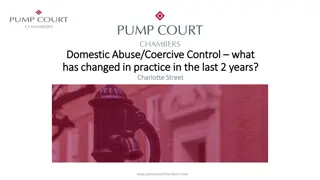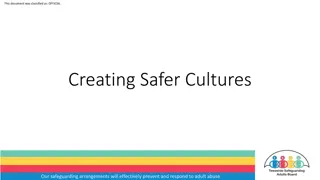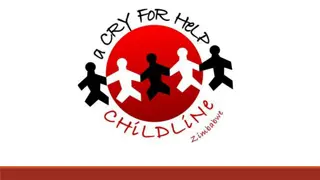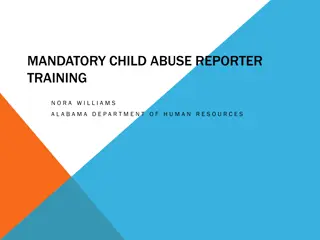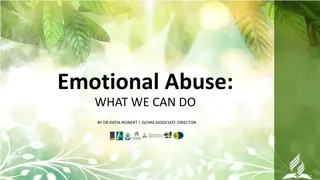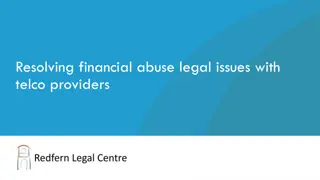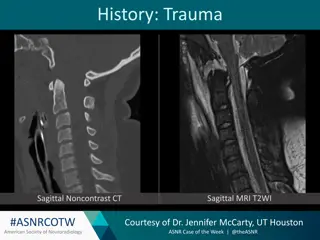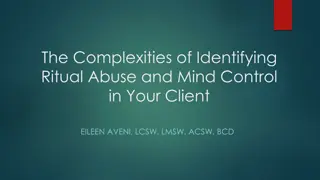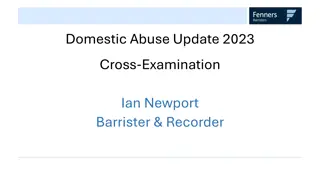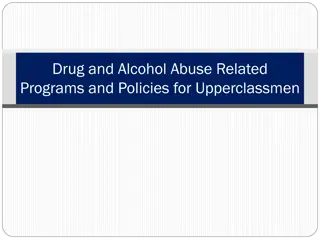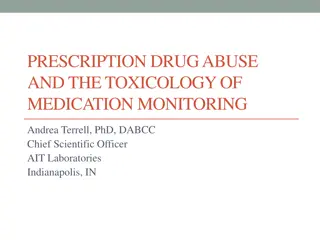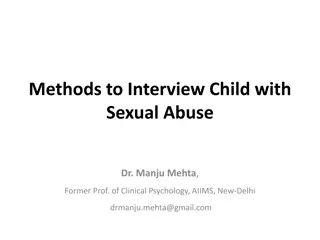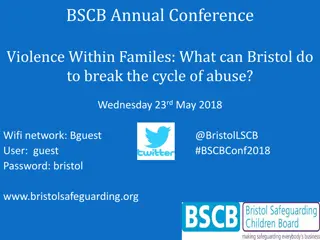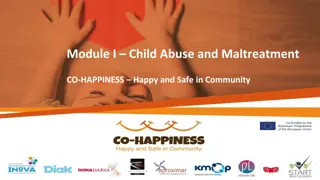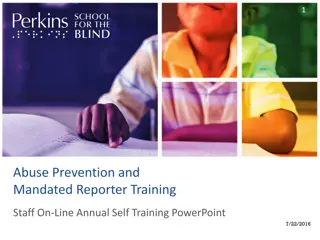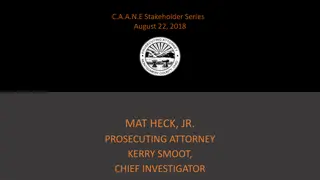
Dissociation, PTSD, and Healing from Trauma
Explore the concepts of dissociation, PTSD, and trauma recovery in Alison Miller, Ph.D.'s book "Healing the Unimaginable." Learn about dissociative disorders, PTSD symptoms, and the impact of trauma on individuals. Gain insights into recognizing, understanding, and healing from these challenging experiences.
Download Presentation

Please find below an Image/Link to download the presentation.
The content on the website is provided AS IS for your information and personal use only. It may not be sold, licensed, or shared on other websites without obtaining consent from the author. If you encounter any issues during the download, it is possible that the publisher has removed the file from their server.
You are allowed to download the files provided on this website for personal or commercial use, subject to the condition that they are used lawfully. All files are the property of their respective owners.
The content on the website is provided AS IS for your information and personal use only. It may not be sold, licensed, or shared on other websites without obtaining consent from the author.
E N D
Presentation Transcript
Healing the Unimaginable Alison Miller, Ph.D.
1 Dissociation and Organized Abuse
Dissociation 4 Recognizing complex dissociative disorders Relating to different parts (alter personalities)
What is Dissociation? (Sidran Institute definition) Dissociation is a disconnection between a person s thoughts, memories, feelings, actions, or sense of who he or she is. This is a normal process that everyone has experienced. Examples of mild common dissociation include daydreaming, highway hypnosis or getting lost in a book or movie, all of which involve losing touch with awareness of one s immediate surroundings. During a traumatic experience such as an accident, disaster or crime victimization, dissociation can help a person tolerate what might otherwise be too difficult to bear. In situations like these, a person may dissociate the memory of the place, circumstances, or feelings about the overwhelming event, mentally escaping from the fear, pain and horror. This may make it difficult to later remember the details of the experience, as reported by many disaster and accident survivors.
Post-Traumatic Stress Disorder PTSD may occur in people who have experienced or witnessed a traumatic event such as a natural disaster, a serious accident, a terrorist act, war/combat, or rape or who have been threatened with death, sexual violence or serious injury. The experience may be indirect, such as learning of harm or death of a close family member or friend, or police officers exposed to horrible details of trauma. People with PTSD have intense, disturbing thoughts and feelings related to their experience that last long after the traumatic event has ended. They may relive the event through flashbacks or nightmares; they may feel sadness, fear or anger; and they may feel detached or estranged from other people. People with PTSD may avoid situations or people that remind them of the traumatic event, and they may have negative reactions to something as ordinary as a loud noise or an accidental touch. People of colour are more likely to have PTSD, and women are twice as likely as men. This is probably because of more traumatic experiences in these groups.
PTSD Symptoms 1. Intrusion: Intrusive thoughts such as repeated, involuntary memories; distressing dreams, or flashbacks of the traumatic event. Flashbacks may be so vivid that people feel they are re- living the traumatic experience or seeing it before their eyes. Avoidance: Avoiding reminders of the traumatic event may include avoiding people, places, activities, objects and situations that may trigger distressing memories. People may avoid remembering or thinking about the traumatic event. They may resist talking about what happened or how they feel about it. Alterations in cognition and mood: Inability to remember important aspects of the traumatic event, negative thoughts and feelings leading to ongoing and distorted beliefs about the cause or others (e.g., I am bad, No one can be trusted ); distorted thoughts about the cause or consequences of the event leading to wrongly blaming self or other; ongoing fear, horror, anger, guilt or shame; much less interest in activities previously enjoyed; feeling detached or estranged from others; or being unable to experience positive emotions. Alterations in arousal and reactivity: being irritable and having angry outbursts; behaving recklessly or in a self-destructive way; being overly watchful of one s surroundings in a suspecting way; being easily startled; or having problems concentrating or sleeping. 2. 3. 4.
Complex Trauma Complex trauma describes both children s exposure to multiple traumatic events often of an invasive, interpersonal nature and the wide-ranging, long-term effects of this exposure. These events are severe and pervasive, such as abuse or profound neglect. They usually occur early in life and can disrupt many aspects of the child s development and the formation of a sense of self. Since these events often occur with a caregiver, they interfere with the child s ability to form a secure attachment. Many aspects of a child s healthy physical and mental development rely on this primary source of safety and stability. (definition by National Child Traumatic Stress network)
Dissociative Splitting 9 Dissociative splitting is an adaptation which enables a child to live with ongoing trauma, in many or most cases involving his or her own parents or caregivers. Dissociative splitting affects survivors awareness of some or all of the traumatic events, the circumstances surrounding the events, and the identity of the abusers, for some period of their lives. When there are specific parts who come out into the world separately, have their own histories, and are often amnestic for what happens when other parts are in control of the body, we call it DID (Dissociative Identity Disorder). When parts do not come out in everyday life but there is evidence of their internal presence, we call it OSDD (Other Specified Dissociative Disorder).
Lesser Dissociative Disorders Dissociative Amnesia Depersonalization/Derealization Disorder Depersonalization: Experiences of unreality or detachment from one s mind, self or body. People may feel as if they are outside their bodies and watching events happen. Derealization: Experiences of unreality or detachment from one s surroundings. People may feel as if things and people in the world around them are not real. During these experiences the person is aware of reality and that their experience is unreal. Symptoms begin in adolescence or childhood. Both Acute Stress Disorder and Posttraumatic Stress Disorder may involve dissociative symptoms, such as amnesia and depersonalization or derealization.
DID and OSDD All survivors of extreme organized abuse have DID (Dissociative Identity Disorder) or OSDD (Other Specified Dissociative Disorder), whether or not they are aware of it. I think of it as mental injury, rather than mental illness. They grow differently because of injury. For simplicity I shall refer to people with both these conditions as multiples. This acknowledges their internal experience. And I ll call those of us who do not have split minds or brains as singletons. Organized groups who abuse children deliberately try to split and structure their victims minds in such a way that they will not remember what happened, or that if they begin to remember they will disbelieve their own memories. Their goal is OSDD. The deliberately created inner parts come out upon instructions or triggers by perpetrators.
What Being the Front Person of a Multiple is Like Feeling as if you are somehow unreal (depersonalization) Feeling as if the world is unreal or you are in the wrong time or place (derealization) Hearing voices, often critical or giving orders or commenting on your life and behavior Not remembering things you have apparently done and having to guess what happened Blanking out (without alcohol) and waking up somewhere else later Feeling differently or having different opinions at different times Being accused of lying about things you can t remember
Inconsistency and Amnesia 14 Multiples grow up in families which are arbitrary dictatorships, where you have to obey adults out of fear, and rules are inconsistent. You have to know and not know not know when you re at school that your parents do horrible things to you at night. Parts are specialized to take pain, have sex, be angry, etc., and often don t like parts with different specialties. One part breaks the rules, another part gets punished. Don t expect the front person to know what another part has done or to be able to control it. Most parts expect abuse and changeability from others.
Understanding Living with Multiplicity Treat a dissociative person with dignity and respect, as you would a foreigner, not as a curiosity. Ask your client to be your teacher about multiplicity. He or she may assume that you and everyone else lose time, disappear from consciousness and wake up somewhere else without knowing what happened, and hear voices. Often a person who is multiple imitates singletons, like a foreigner trying to pronounce a foreign language. Child parts in adult bodies feel especially misunderstood.
Many Parts (People), One Body We singletons expect to be conversing with one person. But it s more like talking with identical brothers or sisters who impersonate one another, change places fast, and look the same but act differently. Look for the physical evidence of them changing places. Learn to recognize body language and maturity level of different parts. The front person may be just a shell who bridges the transitions so switching is not obvious. Do not assume the front person is the real person and the others less real, or that the front person can control behavior of the other parts Do not assume continuity of memory. Some multiples lie to cover for periods of time they don t remember. Parts new to the present are often confused about time and place and date
Its Like Speaking with Many Housemates on the Phone One at a time can control the voice and speak with you. The house has a speaker phone so those nearby (but not everyone) can hear you. You can talk through to others in the house. You can send messages to ones far from the phone. You can ask that others in the house give information to the one on the phone. You re not really on the phone, but you see the person s body, and you may notice he or she pauses as if listening. If this happens, speak more slowly, pause, and repeat yourself, so that the one you re talking with can talk inside as well as with you. You are actually communicating with several people at once.
Parts Identities 19 Usually the majority are children of various ages, split off by events which cut off their circuitry and prevented them from further life experience and growth. Opposite-gender parts are common. Some may be blind or deaf or mute, often from literal responses to abusers words. Some believe they are other people, like perpetrators or soldiers. Some believe they are supernatural or alien beings: demons, ghosts, animals. Each part is very limited in its range of emotions and intellectual capacity. There are often several or many front people. Don t show favoritism among parts.
Issues with Young Child Parts I believe child parts are still developmentally children, though not normal children. Find out the age of the part you are speaking with to assess cognitive maturity; talk as if to a child of that age; Remember others are listening and you should be clear to those ones too. Young child parts have concrete and literal thinking. They may not understand words or concepts such as lying , then versus now, memory. The inner world may be as real to them as the external world. Systems run by very young child parts tend to be chaotic. Infant parts may need to process memories nonverbally with assistance of older parts, so they mature upon joining. They can share their nonverbal memories with parts slightly older, who can translate for them.
Detecting Switches 21 In early therapy, clients switch subtly. Language may change. Content may change while voice sounds the same. Word salad indicates rapid switching. Emotional state may be quite different. Ask if this is someone new, if they know you, if they know where they are. If you suspect it s a child part, ask the age so you can communicate appropriately. Do not ask names.
Detecting Co-Presence 22 You may sense a change in emotional state. Ask Is someone else here? I sense someone is feeling scared Is that you or someone else? Can you tell them who I am and where we are so they won t be so scared? Always assume more than one part is present. I get so I can almost see the new part for example, over the client s right eye or right behind her.
Do You Work with the Front Person? 23 It depends on the functionality of the front person (the one who normally is present for daily life.) If a front person has years of high functioning, you may be able to work with the parts through that front person, and the parts may respect that one, as they bring much strength and experience. If the front person is only a shell, it s wiser not to bother. Just make sure you talk with someone who knows about everyday life, illness, work, etc. every so often. Front person and insider parts often hate one another. You need to do mediation, explaining to each what the other s purpose is, and why they are the way they are. Front people are specialized for handling day to day life and have little or no awareness of the trauma history because that awareness would interfere with their functioning. Insiders hide the pain and the anger and overwhelming knowledge and emotions.
Match Your Style to the Part(s) Presenting 24 It s a dance You shift with their state, as with a baby who laughs then cries. It s attunement. You are often talking with an insider when you think it s the front person, the adult. See how old the person appears from their speech and body language, and match your language to that age. Sound assertive with tough parts, but be careful, as even a slightly raised voice can engender terror. Client may ask or think: Are you going to shout? Are you going to hit me? Some tough parts have tender ones hidden underneath the surface. Parts can themselves be multiple.
Using Inner Voices to Establish Communication with Parts 25 Notice when the client seems to be listening internally. Did someone say something to you? What did they say? Do you know what they mean? Could you ask the person who said that why they said that? Can they explain for me? Do they have any questions for me? They can talk through you. Would they be willing to come out and talk to me so I can understand them better?
Noticing Subtle Reactions, Misunderstandings & Triggering 26 Notice these and address them immediately. Is someone inside reacting to something I said or did? I scratched my ear because it was itchy. It wasn t supposed to be a signal to any of you. Is there something in this room which makes you feel unsafe? Do you need to look around? Should I remove something? Watch for reactions to trigger words which have opposite meanings, e.g. free, love. Try to avoid these words. Figure out what are trigger words for each client.
Improving Inner Communication 27 Demystify multiplicity by explaining how trauma creates a compartmentalized brain, so DID is mental injury, not mental illness. Frequently suggest that the client Ask inside. Just think it in your head, and then listen for an answer. It could be words, or a thought, or a picture. Tell me what answer you received. Do you understand it? Now enter dialogue with the insider through the presenting part. Ask them . Make ask inside a habit in your dialogue with clients.
Complex Multi-System Clients 28 It is all one brain. Information does often reach through barriers even when it isn t supposed to. Some deeper part of the brain holds enough wisdom to know which things to bring up, in what order. It is a system. You don t work with Susie, or Enforcer, or The Whore. You work with the system.
Important Therapist Qualities 29 Consistency Patience for the long haul They sense your sincerity, your tiredness and your fear. They probe you for weaknesses. Acknowledge these; don t pretend they aren t there. Firm and flexible boundaries You can t meet the infant parts needs; you can t keep them safe. Don t make promises you can t keep Look for opportunities to apologize. Perpetrators don t. Intuition in experts is just accumulated learning which is at your fingertips. Practice makes perfect. So take more dissociative clients so you get better at it!
Organized Abuse Definitions Indicators Creation and Training of Parts 30
What is Organized Abuse? Organized abuse involves multiple adults who conspire to sexually abuse one or more children. Organized abuse can include the sexual exchange of children between perpetrators as well as the production and distribution of child sexual abuse material (organisedabuse.com).
Types of Organized Abuse (Michael Salter) Network abuse extra-familial, targeting vulnerable teens, many victims Institutional abuse by staff in child-focused institutions Familial abuse cultures of sexual abuse within families, a small number of victims extensively victimized, early initiation, quick progression to serious abuse, long duration of victimization Ritual abuse structured in a ceremonial or ritualistic fashion, highly abusive, involves torture of children and adults and the manufacture of child abuse material Technology facilitated organized abuse groups of adult abusers connected over the internet
What is Mind Control? 33 Abuse of children (and adults) by an organized group which deliberately creates, indoctrinates, and trains internal parts (alter personalities) Deliberate creation of inside parts in infancy Creation of a planned structured personality system Creation of inner structures and/or an inner world where parts live Beliefs implanted and parts trained to do their jobs through torture, drugs, training and stage magic There are lesser forms of mind control, e.g. through media and/or peer pressure.
What is Ritual Abuse? Ritual abuse is mind control by a religious group. There are organized groups whose religion involves sacrifice to a deity such as Satan and Lucifer. Although Satanic trappings (costumes etc.) are used for the purpose of frightening child victims in pornographic settings, there are also genuine religious groups. There are well-organized Satanic and Luciferian groups who use mind control for the purposes of their religion. Some people define ritual abuse as any abuse done in a ritualized repetitive manner, whether or not religious.
Programming 35 Programming is the act of installing internal, pre-established reactions to external stimuli so that a person will automatically react in a predetermined manner to things like an auditory, visual or tactile signal or perform a specific set of actions according to a date and/or time. (Arauna Morgan) Certain persons within organized abuser groups have the job title of programmer, and are supposed to program victims brains. There is only one way to create persons who can engage in spying, sex slavery, assassination, or ritual murder without any conscious awareness of this. The way is through abuse and torture of small children, separating parts of their minds that are then indoctrinated and trained individually as the abusers see fit.
Groups Who Engage in Mind Control 36 Military or political groups (CIA MK-Ultra, Nazis, KKK) Traditional organized crime (child prostitution, child pornography, drug couriers, assassinations) Religious groups (Satanists, Luciferians, Druids, ancient religions) Secret Societies (e.g. Illuminati, Freemasons occult/political conspiracy) Groups are interconnected. If a person has been trained by one abuser group, he or she is likely to have training by other groups as well. Training centers will train children for different groups, as requested.
Some Mind Control Indicators 38 Your client has been diagnosed with DID or OSDD. Your client hears voices or thoughts ordering him or her not to talk or to be quiet. If your client talks about what may have happened to him or her, s/he experiences symptoms like bodily pain, nausea, a severe headache, spasms as if receiving an electric shock, or flashbacks of violent events. Sometimes your client feels that there is something foreign inside his or her body which can do harm to the client or others, or can signal the client s location or thoughts to abusers. Your client has unexplained scars on his/her body, or scars with a nonsensical explanation. Sometimes your client feels that his or her energy will poison those s/he is close to. Your client worries that he or she will harm or murder someone or that s/he has done so. Your client is preoccupied with or needing to avoid newscasts, articles, or conversations about ritual abuse or mind control.
Some Ritual Abuse Indicators 39 Your client has made drawings characterized by ritual-like features, e.g., lots of red and black, knives, fire, cages, robes, body parts, blood. Your client has worse psychiatric symptoms around his/her birthday, family members birthdays, Christmas, Easter, Halloween, May Day, and early September. Your client has cut patterns, symbols, or letters on his/her own body. Your client finds odd, ritualistic songs or chants running through his/her head, sometimes with a sexual, bizarre, or "you d better not tell" theme. Your client has intrusive thoughts or impulses regarding violent sex, sex with children, or sex with animals. Your client s dreams and/or flashbacks include rituals.
IndicatorsFears and Phobias 40 harm being done to your loved ones or your pets ropes, being tied up, being hung confined spaces basements, crawl spaces, pits, cages death and burial weapons police, jails and cages baths and drowning insects, snakes, spiders and rats birthdays and weddings religion and church Christmas and Easter doctors, dentists, hospitals injections and needles bodily fluids and excretions red meat and/or certain other foods cameras and being photographed specific colors or shapes
Qualifiers of Indicators 41 Some of the fears (like needles or insects or the dentist) are common. If your client has these, does s/he have a way to account for them in his or her life history? Others of the fears, and the non-fear items, are uncommon. Does your client experience any of the uncommon ones? Does s/he have a way to account for them in his or her life history? If you gave your client the list of indicators to check off, look at the entire pattern of the client s answers. No single one of these items means he or she has a history of ritual abuse or mind control. However, if s/he says yes to a large number of them, you might suspect such a history. (Thanks to Pamela Reagor, Catherine Gould, & Ellen Lacter for earlier lists)
So, We Covered Trauma, complex trauma, and dissociative disorders (definitions) Communicating with persons who are multiple Organized abuse, mind control and ritual abuse (definitions) Recognizing survivor clients

